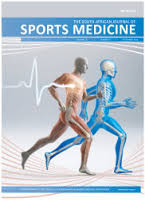Gait retraining as part of the treatment programme for soldiers with exercise-related leg pain: preliminary clinical experiences and retention
DOI:
https://doi.org/10.17159/2078-516X/2017/v29i1a3019Abstract
Background: Gait retraining as part of a treatment programme for exercise-related leg pain (ERLP) was introduced in the sports medicine department of the Royal Netherlands Army in 2013.
Objectives: To describe clinical experiences and retention of gait retraining in a military setting.
Methods: Sixty-one cases from the year 2015 were available for analysis of gait and gait retraining. In 2016, 32 of these patients were available for a follow-up survey, 28 of them also for the follow-up measurement of running biomechanics in running shoes.
Results: Soldiers received an outpatient treatment programme that lasted on average 129 days (SD 76). On average they received 2.4 gait retraining sessions, leading to significant and lasting changes in running biomechanics; in particular, reduction in maximal force (N) and maximal pressure (N/cm2) on the heels at 317 days follow-up (average, SD 108). Most soldiers were satisfied with gait retraining. At follow-up, 27 soldiers (84%) contributed some, the majority or all reduction of symptoms to it. Seventy percent reported that they had mastered the new running technique within two months. The Single Assessment Numeric Evaluation score increased from 55% to 78% for males and from 44% to 75% for females.
Discussion: This is the first study to report on gait retraining for Medial Tibial Stress Syndrome. In future, prospective studies in the military running in shoes and running in boots respectively should be investigated.
Conclusion: Soldiers with exercise-related leg pain (ERLP), among them patients with Medial Tibial Stress Syndrome, respond well to a treatment programme that included gait retraining. Ten months post-gait retraining, their running biomechanics still showed these positive changes from their time of intake.
Downloads
Downloads
Published
Issue
Section
License
Copyright (c) 2017 South African Journal of Sports Medicine

This work is licensed under a Creative Commons Attribution 4.0 International License.
The South African Journal of Sports Medicine reserves copyright of the material published. The work is licensed under a Creative Commons Attribution 4.0 (CC BY 4.0) International License. Material submitted for publication in the South African Journal of Sports Medicine is accepted provided it has not been published elsewhere. The South African Journal of Sports Medicine does not hold itself responsible for statements made by the authors.
How to Cite
- Abstract 561
- PDF 563
Metrics

- Citations
- Citation Indexes: 5
- Usage
- Full Text Views: 293
- Abstract Views: 77
- Captures
- Readers: 19





.png)